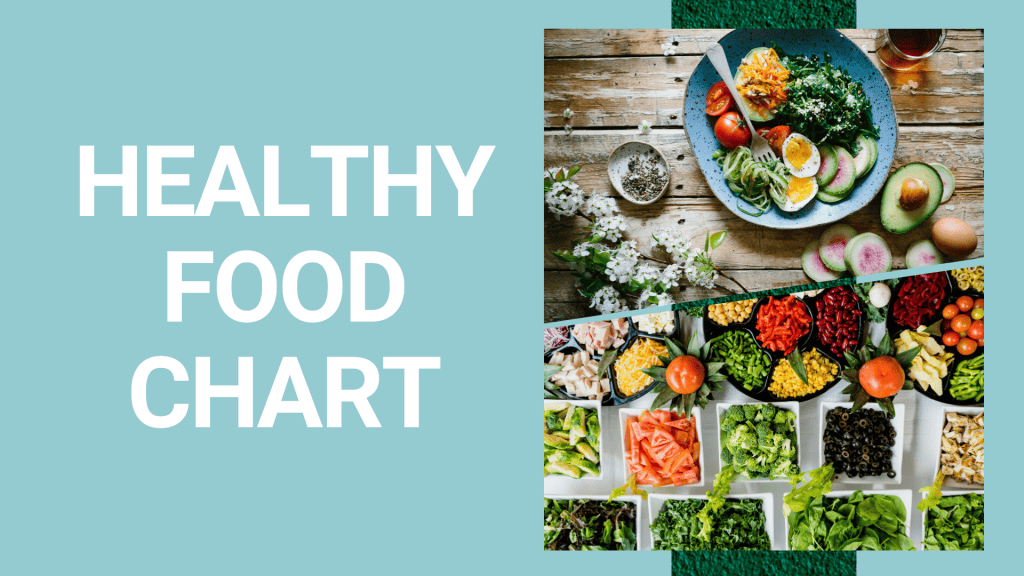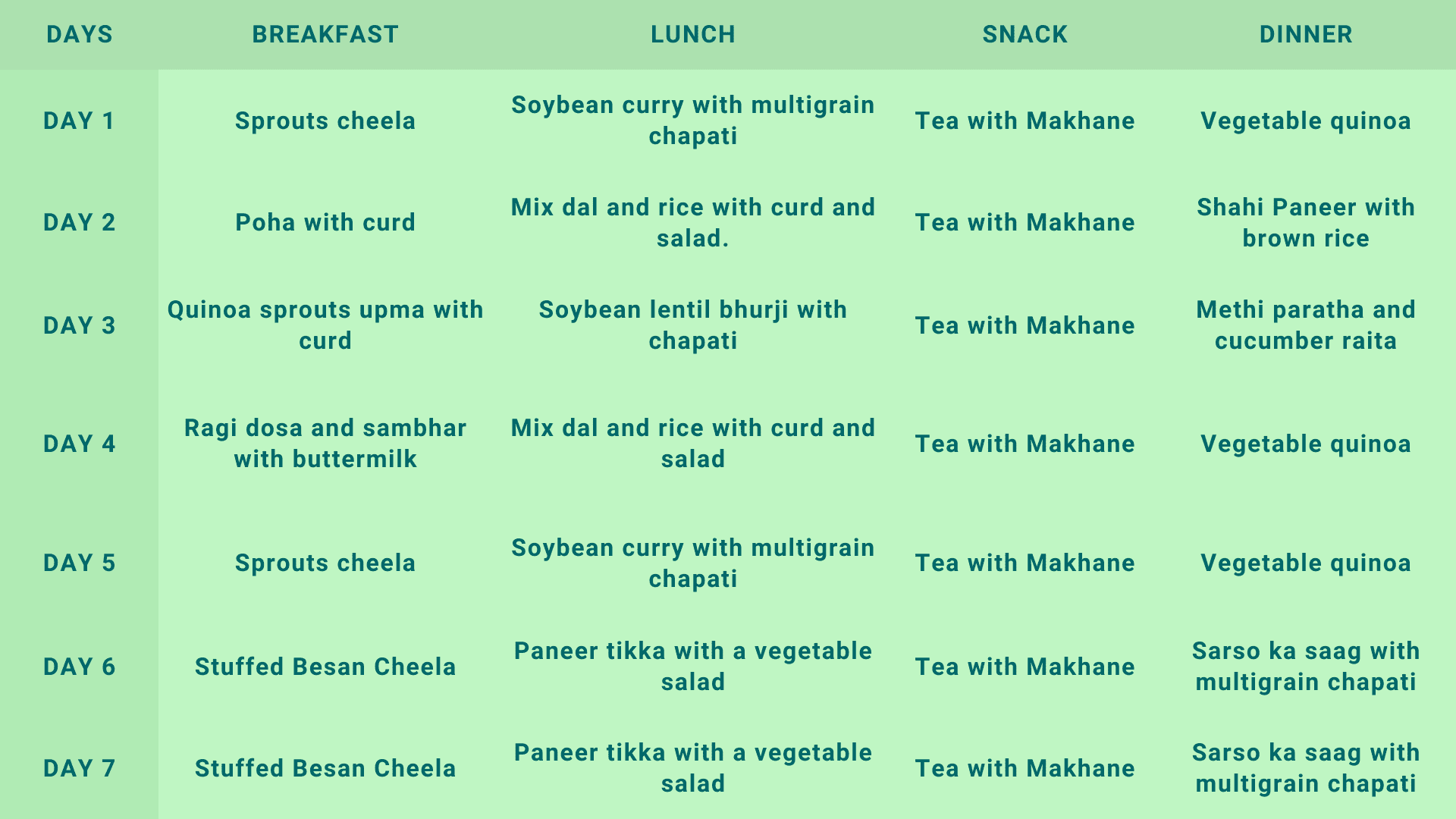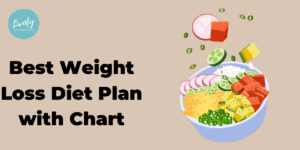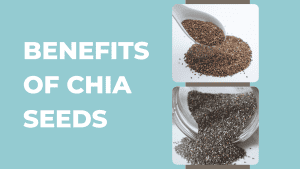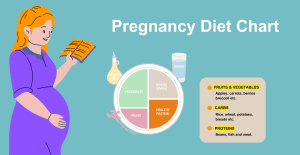A healthy food chart comes in handy when you are trying to stay healthy, and for that, you should add all the good and considerable amounts of nutrient-rich foods like fruits, veggies, whole grains, lean meats, and healthy fats because those are packed with all the high-protein and nutrients your body needs to keep going healthy and strong. But, figuring out how to make a healthy food chart can be tricky if you are thinking about specific diets like Indian food diet or trying to gain or lose weight. Luckily, this blog breaks it down for you, explaining what should go into a healthy food chart and giving you tips on making your own.
What is a Healthy Food Chart?
Healthy food chart is similar to a guide, which helps you identify which foods to eat and in the right amounts so that you can remain fit and in good health. A healthy food chart includes nutrient-rich foods such as fruits, vegetables, whole grains, lean proteins and healthy fats that help you plan your meals to ensure you get all the essential nutrients your body needs to feel healthy. A healthy diet chart is a way to balance your meals with different nutrient-rich and protein-rich foods to get enough of every nutrient without eating too much of one type of food. Following the healthy food chart, you can eat foods that give energy and keep the body healthy, helping control weight and lowering the chance of long-term illnesses. It’s beneficial for anyone who wants to eat better and stay healthy!
Healthy Diet Chart for Male
Maintaining excellent health for men is about having a diet full of essential nutrients, vitamins, and minerals because these are crucial to avoiding illnesses and feeling healthy. When making a healthy diet chart, it is necessary to include many lean proteins and Biotin rich foods like chicken, turkey, fish, eggs, tofu, paneer and beans for strong muscles. Also, remember that whole grains such as brown rice or quinoa give steady energy throughout the day, and eating many fruits and vegetables offers essential vitamins and antioxidants. Incorporating them with healthy fats from avocados and nuts helps keep your brain smart and your heart strong. Here is a healthy food chart for males.
Here is the balanced diet chart for males
| Healthy Food Chart for Males | |||||
| Breakfast | Paneer Paratha and Raita (350-450 calories and 13-17 grams of protein with 1 paratha only) | ||||
| Lunch | Rajma with Whole Wheat Chapati (450-490 calories and 21-23 grams of protein with 2 chapatis only) | ||||
| Snack | Fruit Salad (180 calories and 2.4 grams of protein in 1 bowl) | ||||
| Dinner | Whole Wheat Roti and Mix Veg Sabji (340-440 calories and 12-16 grams of protein with 2 chapatis only) | ||||
Breakfast
- Paneer Paratha and Raita
Paneer contains good amounts of protein with all the essential amino acids, and raita aids digestion and boosts the body’s immunity. Just make sure the paratha is cooked in healthy oils, which will help reduce the calories and make it more nutritious. Add this food to your healthy food chart to enjoy its benefits, and also check out some amazing and healthy recipes to add to your diet.
Lunch
- Rajma (Kidney beans) and Whole Wheat Chapati
Rajama is one of the great sources of protein, and consuming it can fulfil the protein requirement of the body and the fibres present in it will also help in digestion. On the other hand, whole wheat chapati is an excellent source of complex carbs, providing the body with a slow and constant release of energy. You can add this to your healthy diet chart to ensure you don’t skip eating it. You can read more about nutrition on our blogs.
Snack
- Fruit Salad with Nuts
Fruits are a great source of many essential vitamins and minerals, and they are the best choice for making a salad or snacking. You can add fruits such as watermelon to your healthy food chart. It is filled with Vitamin C and Vitamin B6.
Dinner
- Whole Wheat Roti and Mix Veg Sabji
Whole wheat roti is a great source of carbs which is a great source of complex carbs that provide the body with a constant and slow release of energy without causing an energy crash. Adding mixed veg sabzi to your healthy diet chart allows you to enjoy the benefits of various vitamins and minerals. You can discover more amazing food combinations in a 7 days diet plan for weight loss.
Healthy Diet Chart for Female
Keeping a balanced and nutritious diet is extremely important for women’s health as it helps control hormones, supports reproductive well-being, and lowers the chances of getting sick. Here is an easy guide to making your own healthy food chart to ensure you eat different nutrient-rich foods like fruits, vegetables, whole grains, and lean proteins. While creating a portion control healthy diet chart for women, balanced meals are important to maintain stable blood sugar levels, and starting the day with a nutritious breakfast and eating mindfully by listening to body signals is a great start. Eating healthy is important because it helps keep energy long and improves overall well-being, ensuring you feel good in every part of life.
Here is the balanced diet chart for females
| Healthy Food Chart for Females | |||||
| Breakfast | Quinoa with Eggs and Veggies (412 calories and 22 grams of protein with 1 serving of mixed quinoa, 2 eggs and vegetables) | ||||
| Lunch | Chicken Salad with Veggies (337 calories and 37 grams of protein in 1 serving of mixed chicken salad with veggies) | ||||
| Snack | Fruit Salad with Nuts (260 calories and 6-8 grams of protein in 1 serving of fruit salad with nuts) | ||||
| Dinner | Whole Wheat Pasta with Veggies (343 calories and 9-12 grams of protein in 1 serving of wheat pasta with veggies) | ||||
Breakfast
- Quinoa With Eggs and Veggies
You can add quinoa to your healthy food chart as it will provide the body with slow-releasing carbs. As we all know, eggs contain protein, and veggies are home to fibre and various vitamins and minerals. Just like eggs, here are some low calorie foods.
Lunch
- Chicken Salad with Veggies
Chicken is a great source of lean protein, which contains all the essential amino acids your body needs to repair and build muscle after a workout. Adding it to your healthy diet chart can be really helpful.
Snack
- Fruit Salad with Nuts
Fruits contain many essential vitamins and minerals, and adding nuts to your healthy food chart will provide the body with healthy fats, which can help improve cardiovascular health.
Dinner
- Whole Wheat Pasta with Veggies
Whole wheat pasta is a good source of carbohydrates, which provide the body with energy. Vegetables are high in fiber and various vitamins and minerals, such as vitamins A, C, E, Zinc, and magnesium, and should be added to a food health chart.
Healthy Diet Chart for Kids
Your child’s health begins with what they eat, and it’s very important for their growth and overall happiness. This guide helps create a healthy eating plan that is personalized for kids. This diet chart covers everything from yummy fruits and veggies loaded with all the lean proteins they need to help their body grow big and strong. Let’s not forget about High calorie foods and whole grains like brown rice and oats because they give them a lot of energy. Make sure half their plate is filled with colourful fruits and veggies, add in some protein about the size of their palm and use whole grains as the base of their meals.
Here is the balanced diet chart for kids
| Healthy Food Chart for Kids | |||||
| Breakfast | Multigrain Chapati with Veggies and Milk (300-350 calories and 10-15 grams per serving) | ||||
| Lunch | Chapati with Vegetable Curry (250-300 calories and 5-10 grams per serving) | ||||
| Snack | Fruit Salad (100-150 calories and 1 gram per serving) | ||||
| Dinner | Chapati with Milk (200-250 calories and 7-10 grams per serving) | ||||
Breakfast
- Multigrain Chapati with Veggies and Milk
Multigrain chapati is a good source of complex carbs, and veggies have fiber. Milk contains a good amount of protein with all the essential amino acids and makes a great addition to the food health chart for kids.
Lunch
- Chapati with Vegetable Curry
Chapati provides the body with energy, and vegetables have various vitamins and minerals in them.
Snack
- Fruit Salad
Fruits are a great source of various vitamins and minerals, such as Vitamin C and Zinc, and adding them to a food health chart can be really beneficial.
Dinner
- Chapati with Milk
Chapati contains carbs, and milk has protein with all the essential amino acids, making it important to add to a food health chart.
Healthy Diet Chart for 7 days
A healthy diet chart acts as our compass on the path to good health because it helps us follow our nutrition targets and ensures we have a balanced intake of necessary nutrients and proteins. Investing time into arranging our healthy diet chart provides us with a direct strategy on how to eat and what items should be consumed.
However, when life is full of problems, we tend to skip meals or choose unhealthy options. This is where a 7-day healthy diet chart proves very useful because it acts like our hidden weapon, guaranteeing we eat properly even during busy times.
What are the 10 most healthy foods?
The top 10 healthy foods consist of spinach, which is fantastic because it’s packed with vitamins and minerals, boosting your overall health. Then there’s kale, which is full of antioxidants and fiber, so it helps with digestion and keeps your heart healthy. Blueberries are a superfood everyone loves because they’re loaded with antioxidants, which are great for brain health. Salmon is another favourite because it’s rich in omega-3 fatty acids, supporting heart and brain function. Quinoa is fantastic, too, especially if you need a high-protein, gluten-free grain packed with nutrients.
Greek Yogurt is another great choice because it’s rich in probiotics, which aid digestion and promote gut health. And remember avocados, which offer healthy fats and vitamins that are excellent for your heart and help keep you full longer. Almonds are a nutrient powerhouse because they provide healthy fats, protein, and fiber. Sweet potatoes are delicious and packed with vitamins and antioxidants, supporting your immune system and digestion. Finally, broccoli is a superstar because it’s filled with vitamins, minerals, and fiber, boosting your overall health and immunity.
Here are 10 most healthy foods to add to your diet:
- Spinach: Rich in vitamins and minerals for overall health.
- Kale: Packed with antioxidants and fiber, supporting digestion and heart health.
- Blueberries: Superfood loaded with antioxidants, great for brain health.
- Salmon: Excellent source of omega-3 fatty acids, benefiting heart and brain function.
- Quinoa: High-protein grain alternative, gluten-free and packed with nutrients.
- Greek Yogurt: Probiotic-rich, aiding digestion and supporting gut health.
- Avocado: Healthy fats and vitamins, promoting heart health and satiety.
- Almonds: Nutrient-dense, providing healthy fats, protein, and fiber.
- Sweet potatoes: Nutrient-rich carbohydrate, high in vitamins and antioxidants.
- Broccoli: Packed with vitamins, minerals, and fiber, supporting overall health and immunity.
How to make a Healthy diet chart?
Making a healthy diet chart that works for you requires looking at many elements that Improve your health together, and for that, you should look at what kinds of food you eat, such as fruits, vegetables, grains, proteins, and good fats, which benefit your health. While It’s not only about what you eat, it’s also about how much you eat, and for that, you need to watch portion sizes, making sure you are not eating too much but still getting enough food to stay full and have energy.
Also important is balancing nutrients means having the right mix of carbohydrates, proteins, healthy fats, Vitamin B12 foods, and minerals in your diet. Maybe it doesn’t seem very easy, but it is just about eating different foods and paying attention to what your body needs. It is good to be flexible and change how you eat to fit your life and what you like. If you ever feel confused or need help with what to do, consult a dietitian or certified nutritionist for some personal advice. This helps you feel great inside as well as outside. Here are some important points to remember before making a healthy diet chart.
Identify food groups
- Before making a healthy diet chart consider the various types of foods you require which involve fruits, vegetables, grains, proteins (like meat fish, and beans) and beneficial fats (like olive oil and nuts). Each group gives your body different nutrients it needs to stay healthy and strong.
Portion sizes
- It is not only about what you eat but also how much you eat, which depends upon people’s need for different quantities of food depending on their age, gender, and activity level. It is extremely important to understand the right portion sizes for you.
Nutrient balance
- The body needs a combination of different nutrients like carbohydrates (found in foods such as bread and pasta), proteins (in meat fish, and tofu), and fats (like those found in avocados and olive oil). Also, you require vitamins and minerals from fruits and vegetables to ensure everything Roles well.
Variety
- Eating many kinds of foods from every group helps you get all the nutrients your body needs. Changing it up with different colours and tastes makes meals more exciting plus it ensures you’re getting a good mix of vitamins and minerals.
Seasonality
- Picking fruits and vegetables in season means you get them when they are at their best. They generally taste better and have more good nutrients when they are fresh. Try to choose what is in the season to enjoy the best of nature’s benefits.
Meal planning
- Planning your meals and snacks ahead of time can help keep you on the right path to healthy eating. It also makes buying groceries easier and lowers the chances of food going to waste.
Flexibility
- It is important to be flexible with your eating plan to fit your lifestyle and likes and always try to stay calm about changing elements or tasting new foods or recipes.
Consultation
- When you don’t know where to begin or need advice talking with a dietitian or nutritionist is a good idea. They can help you make a special eating plan for your needs and goals.
Benefits of following a Healthy Food Chart
A healthy food chart full of nutrient-dense foods like lean proteins, whole grains, and different fruits and vegetables are the best food options for your body as they help with many things, such as repairing muscles and strengthening the immune system. But here is the important thing: when you pick what to eat, choosing the healthy foods and reducing the unhealthy ones like trans fats and added sugars, you are not only caring for your heart, but you are also decreasing the risk of getting illnesses. And believe this, eating well isn’t just good for your body; it also benefits your mind. Also, when you eat healthy food regularly, it feels like building a strong base for good health in future. Here are the benefits of following the Healthy Food Chart.
Balanced nutrition
- When talking about living healthy, it is not only about the food you eat but also about being active, which is also important to maintain great health. The Healthy Diet Chart recommends eating a good amount of healthy foods and being active while concentrating on eating healthy carbs like vegetables, fruits, whole grains, and beans, which are much better for you than other carb sources.
- But you should be careful with sugary drinks like sodas and sweet teas because these drinks don’t help you much but have many calories. It is extremely important not to drink those sugary drinks if you can. Instead, you can add healthy fats like olive oil or avocado oil to your diet because they are good for your health.
Improved Health
- Understanding how to take care of your health is very important because, let’s face it, heart problems like high blood pressure can be extremely scary, leading to elements like heart attacks and strokes. But you can keep your heart strong and healthy just by making some simple changes to your diet, which is all about eating foods packed with a lot of vegetables, fruits, and whole grains while also enjoying lean proteins like fish and poultry and don’t forget about dairy products that are not just for strong bones they also help keep your heart in great shape.
- High-fiber foods are your heart’s best friend because they help with blood sugar level control and cholesterol to lower the risk of heart disease, strokes, and even diabetes, while trans fats are like the villains of heart health, causing all sorts of trouble like clogging up your arteries. You should cut them from your diet and say hello to a healthier heart. When it comes to keeping your blood pressure in check, watching your salt intake is important because foods may taste good, but they’re loaded with salt, which can cause your blood pressure to rise.
- Remember your bones and muscles; calcium, vitamin D, and protein are the best foods for keeping them strong, loaded up on leafy greens and lean proteins. Eating a balanced diet full of fruits, veggies, nuts, and seeds isn’t just good for your heart. It’s also great for your skin and hair and can even help you live longer by reducing your risk of chronic diseases.
Weight management
- You might not know it, but having too much weight can really stress our bodies, which makes us more likely to have serious health issues such as heart disease, type 2 diabetes, joint pain from osteoarthritis, and even some types of cancer. Yes, it feels a bit frightening to consider, but here is the positive side, we have more control over our health than anybody else, so by adjusting small things in our diet, we can see big improvements.
- So, instead of picking those processed snacks, why not take fresh vegetables or fruits? They are tasty and filled with nutrients that our bodies need, and listen to this: we don’t need to count every calorie. A study says that we can decide how much food to eat by looking at our age and activity level and that eating foods with much fibre and lean proteins helps us lose extra weight without worrying about each small calorie. Quality is more important than quantity, so we should avoid processed foods and choose real and whole foods instead. We can manage our weight and stay well by making a diet plan with good balance and many healthy foods.
Increased energy
- Think about foods like carbohydrates, lean proteins, and healthy fats; they are like the strong team for your nutrition. They work together to keep you full of energy and help stop feelings of being tired or lazy. Nutrition experts say that when you eat good food, you give your body what it needs to make the energy it uses every day. This also helps avoid a lack of nutrients, which can make you feel very exhausted later on. Take some oranges, apples, grapes, carrots, or beetroot and make a tasty juice full of nutrients. This drink will give you the energy to handle the hot sun all day.
- Here’s something interesting: having a balanced diet is not only about giving you energy; it also helps maintain your sex life and health. Yes, that’s correct! If you have problems like early ejaculation or not feeling great in the bedroom, what you eat might be a reason. Adding foods such as high-protein dry fruits and vegetables can help increase your sex drive naturally. Also, eating healthy can improve things like blood flow and hormone levels, which are very important for a good sex life.
Enhanced mood
- When it comes to our health and how we feel, what we eat plays an important role, and a recent study has looked into this and found some pretty interesting and eye-opening examples, like eating lots of sugary drinks, pastries, and white bread loaded with lots of refined carbs could make you feel more tired and down, especially if you’re dealing with obesity. And here is the thing: if you go for foods like veggies, fruits, and whole grains, which have less refined carbs, you might feel a bit happier.
- Nutritionists have been digging into how our food choices affect important things like our blood sugar and immune system, and diets like the Mediterranean diet, with lots of healthy protein-rich and nutritious food sources like fish, might actually help boost our mood. A lot of brain-boosting foods are part of the Mediterranean diet, and eating a lot of red meat, processed foods, and fatty stuff might not be doing us any favours when it comes to feeling good. So, what we eat can greatly impact how we feel inside and out. It’s not just about staying healthy but also about keeping our minds happy and strong.
Reduced risk of chronic diseases
- In today’s busy world, it’s extremely normal to worry about serious health issues like heart disease and diabetes, and stressing over it will not solve this problem. Here is an easy fix right at your fingertips: eat a balanced diet full of important nutrients. You know a considerable amount of fruits, vegetables, whole grains, and lean proteins that experts recommend can seriously cut down your risk of getting these chronic diseases. Loading up on antioxidants found in nutrient-rich foods like berries, veggies, nuts, and seeds can actually shield your cells against cancer-causing viruses.
- From delicious berries to leafy greens that everyone talks about and even simple pumpkin seeds, a wide range of antioxidant-rich foods are ready for you to enjoy. Eating a balanced diet not only helps lower your chance of getting cancer but also keeps your weight in control, as studies have shown. If you have diabetes, consider it like a special chance to control your blood sugar levels, keep an eye on your blood pressure, and make sure your cholesterol stays good.
Better digestion
- Bacteria in our gut help to digest food and make sure everything works well, and some of these bacteria even make vitamins that are extremely important for our colon, like vitamins K and B, which protect our bowel health by fighting bad bacteria. Studies show that if we eat a considerable amount of foods with a considerable amount of fibre, like vegetables, fruits, beans, and whole grains, it can help reduce inflammation in our stomachs and make us feel calm and comfortable.
- But that’s not all! Fermented food like yogurt is a considerable amount of probiotics that can help with elements such as irritable bowel syndrome (IBS). We should eat a considerable amount of foods that have plenty of fiber to keep our gut healthy from what we eat. When our gut feels good, we feel good, too!
Stronger immune system
- Your immune system is similar to your body’s private guard, always prepared to protect you from germs and viruses hiding everywhere. It is a very complex group of cells and organs that cooperate to keep you well. But here’s an important point: when your immune system is strong, it can help you recover from illnesses fast. Your immune system helps fight colds and flu and is crucial in dealing with serious diseases like cancer.
- What you eat plays a huge role in keeping your immune system in perfect shape. This, in turn, utilizes nutrition like fuel for your body, and your immune system needs plenty of it to do its job effectively. Building a healthy immune system is all about getting a good mix of nutrients from nutrient-dense and high-protein foods, which means loading up on fruits, veggies, lean proteins, and healthy fats.
- Vitamin C is a very important element in making your immune system stronger, and you can find it in fruits such as oranges and strawberries, as well as in vegetables like broccoli. And then there’s the protein that your immune system loves greatly, which comes from high-protein food sources like chicken, fish, beans, and nuts. Remember that vitamin D is a natural source from the sun that ensures your immune system stays strong. You can find it in protein-rich foods like fatty fish and fortified milk, as well as just by spending time in good old sunshine. Eating a balanced diet full of nutrients that strengthen your immune system can help your body fight sickness and stay in very good health.
Expert Review on Healthy Food Chart
A nutrition expert can’t stress enough how important it is to follow a healthy food chart because this handy guide helps you choose foods full of nutrients like fruits, vegetables, whole grains, lean proteins, and healthy fats, which are essential for keeping you healthy and strong. For example, adding spinach and kale to your meals is fantastic because they are loaded with vitamins and minerals. Remember blueberries, which are great for brain health, and salmon, which supports your heart and brain due to its omega-3 fatty acids. Think about adding high-protein foods like Greek yoghurt and quinoa, which is a gluten-free grain, and also avocados and almonds, which provide healthy fats that are good for your heart; sweet potatoes and broccoli are excellent choices because they offer vitamins and antioxidants.
Planning your meals with a balanced diet helps in many ways because it keeps your energy levels up, boosts your mood, and can even help you manage your weight; plus, eating a diet rich in nutrient-dense foods can reduce the risk of chronic diseases like heart disease and diabetes. If you’re ever unsure about what to eat, consulting a dietitian can provide personalized advice to keep you on the right track, so next time you’re at the grocery store, think about these tips and try to fill your cart with a variety of healthy foods because remember, it’s not just about what you eat, but also about how much you eat and how balanced your meals are; by following a healthy food chart, you can enjoy a happier, healthier life with more energy and better overall health.
References
“Healthy diet.” n.d. World Health Organization (WHO). Accessed May 27, 2024. https://www.who.int/initiatives/behealthy/healthy-diet.
Koh, Jia N. n.d. “Support your Immune System through a Healthy and Balanced Diet.” College of Health and Human Sciences. Accessed May 27, 2024. https://www.chhs.colostate.edu/krnc/monthly-blog/support-your-immune-system-through-a-healthy-and-balanced-diet/.
Marengo, Katherine. n.d. “Benefits of eating healthy: Heart health, better mood, and more.” MedicalNewsToday. Accessed May 27, 2024. https://www.medicalnewstoday.com/articles/322268.
Olsen, Natalie, and Alex Novakovic. n.d. “The top 15 healthful foods: Pulses, vegetables, proteins, and more.” MedicalNewsToday. Accessed May 27, 2024. https://www.medicalnewstoday.com/articles/245259.
FAQs
1. What is a healthy diet menu?
A healthy diet includes plenty of lean protein, vegetables, fruits, and whole grains while limiting high-fat foods such as red meat, cheese, and baked goods. It also reduces high-sodium foods like sandwiches, pizza, soup, and processed foods and reduces foods and drinks with added sugar.
2. What is a healthy food guide?
A healthy food chart is a resource of personalised information on nutritious foods, meal planning, and dietary needs that support overall well-being. It incorporates nutrient-rich foods like fruits, vegetables, whole grains, lean proteins, and healthy fats into daily meals, alongside suggestions for portion control, cooking techniques, and healthier food selections.
3. How to prepare a healthy diet chart?
To prepare a healthy diet chart, prioritize consuming fish, poultry, beans, and nuts while limiting the intake of red meat and cheese, avoiding processed meats such as bacon and cold cuts, and opting for whole-wheat bread, whole-grain pasta, and brown rice variety instead of whole grains, and reducing consumption of refined grains such as white rice and white bread.
4. Why is healthy food important?
Healthy food is important because it forms the foundation for good health and nutrition and protects us against chronic diseases like heart disease, diabetes, and cancer. To maintain a balanced and healthy diet, it is important to consume a diverse range of foods while minimizing the intake of salt, sugars, saturated fats, and trans fats.

